
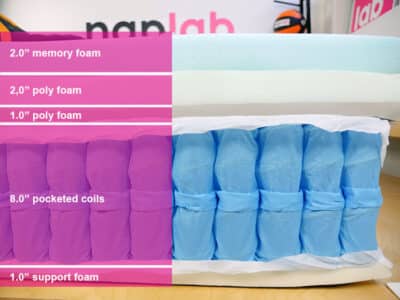
Memory Foam
Best For
- Usually better at isolating motion
- More dramatic body contouring and pressure relief
- No noise
Considerations
- May have worse edge support
- Memory foam can sometimes retain heat
Hybrids
Best For
- Usually faster response time and less exacting hugging contour
- Typically more bounce
- Better edge support
Considerations
- May have more motion transfer than foam
- Generally has a more restrained and generalized body contour
Summary
Memory foam vs. hybrid mattresses—which is right for you? Between these two mattress types, both offer a different feel and performance.
Based on our tests, hybrid mattresses outperform memory foam mattress on average. Most notably, hybrids have better cooling, more bounce, are better for sex, and have better edge support. The layer of coils also gives them a more traditional and familiar feel for many sleepers.
However, it’s not all bad for memory foam. Memory foam mattresses have notably less motion transfer, a more dramatic and exacting body contouring hug, and less bounce. For many sleepers, the more significant hug of memory foam creates better comfort and pressure relief.
In This Comparison
Best Models | Comparison | Memory Foam | Hybrids | Summary | FAQ
Best Memory Foam Mattresses
| Mattress | Score | Read Review | Check Price |
|---|---|---|---|
| Amerisleep AS3 Foam | 9.64 | Read Review | Check Price |
| BedInABox | 9.62 | Read Review | Check Price |
| Zoma | 9.62 | Read Review | Check Price |
| BedInABox Eco-Lux | 9.57 | Read Review | Check Price |
| Loom & Leaf | 9.56 | Read Review | Check Price |
Best Hybrid Mattresses
| Mattress | Score | Read Review | Check Price |
|---|---|---|---|
| Winkbed | 9.95 | Read Review | Check Price |
| Saatva | 9.95 | Read Review | Check Price |
| Purple Hybrid | 9.85 | Read Review | Check Price |
| Diamond Flurry Lux | 9.84 | Read Review | Check Price |
| Winkbed Plus | 9.82 | Read Review | Check Price |
Are Memory Foam or Hybrid mattresses better?
We conduct data-driven and objective tests for every mattress we review (see how we test here). Each mattress has 33 individual data points that are recorded and analyzed.
The comparison chart below looks at the average performance for each category based on all memory foam and all hybrid mattresses we have tested to date.
| Factor | Memory Foam | Hybrid |
|---|---|---|
| Cooling (score) | 9.30 | 9.51 |
| Sinkage (inches) | 2.17″ | 2.31″ |
| Motion Transfer (m/s2) | 4.04 | 7.40 |
| Response (seconds) | 0.63 | 0.52 |
| Bounce (inches) | 6.19″ | 10.79″ |
| Edge Support (inches) | 5.21″ | 4.38″ |
| Sex (score) | 9.15 | 9.68 |
| Pressure Relief (score) | 9.48 | 9.52 |
| Off-gassing (days) | 3.08 | 3.31 |
Based on the results of our tests, we can make the following generalizations about memory foam vs. hybrid mattresses.
Are memory foam or hybrid mattresses cooler?
Hybrid mattresses are typically cooler than memory foam mattresses. The coils just allow for more airflow.
Memory Foam
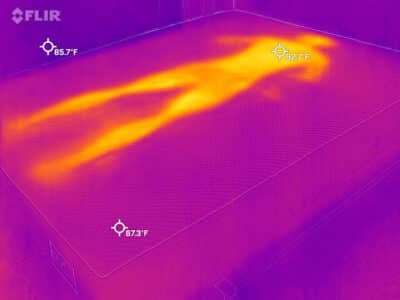
Hybrid
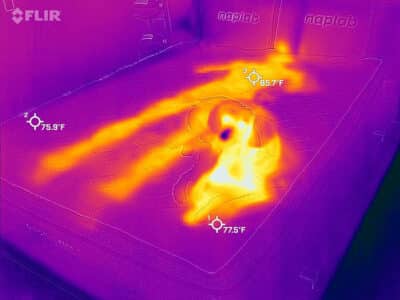
Modern memory foam may offer improved cooling through a couple strategies, ex: perforated or convoluted foam, gel-infused memory foam. or copper-infused foam. However, hybrid mattresses still are typically cooler.
Do memory foam or hybrid mattresses have more sinkage?
In our tests, hybrid mattresses had slightly more sinkage than memory foam mattresses, but exact sinkage depends on the mattress.
Memory Foam
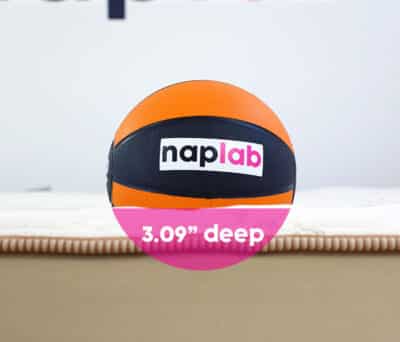
Hybrid
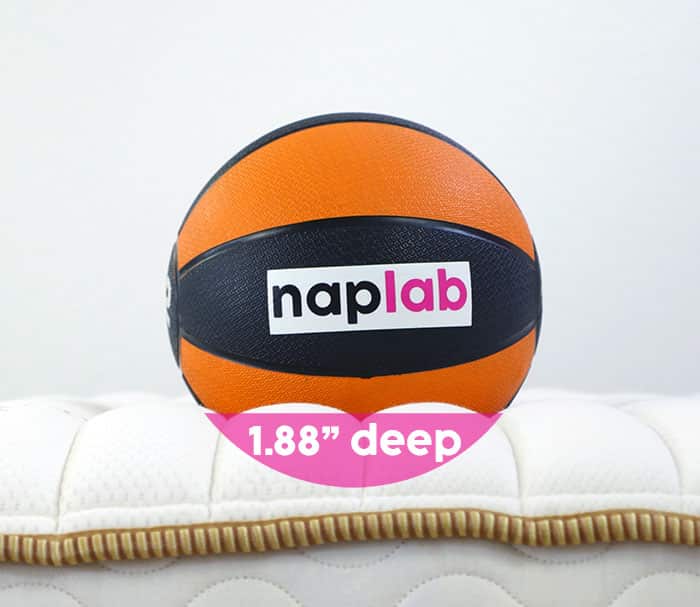
On average, we have measured 2.17″ of sinkage on all memory foam mattresses we’ve tested. By comparison, on average, we have measured 2.31″ of sinkage on all hybrid mattresses we’ve tested.
Do memory foam or hybrid mattresses have less motion transfer?
Memory foam mattresses typically have less motion transfer than hybrid mattresses. See the example video of motion transfer on the Ashley Sleep Gruve memory foam mattress below.
This kind of foam is perfect for absorbing motion and limiting energy transfer across the mattress. Hybrid mattresses utilize a layer of coils, which almost always means more motion relative to an all foam mattress.
Do memory foam or hybrid mattresses have a faster response time?
Hybrid mattresses have a slightly faster response time than memory foam mattresses, but the average difference is small. See the example video of ultra slow response speed from the Nectar Classic below.
The top comfort foam layers are more critical when it comes to faster response, with more traditional memory foams being slower than memory foam, which is slower than poly foam, which is slower than latex / responsive poly foam. Hybrids often use the same types of comfort layers as all foam memory foam mattresses, so response can be similar.
Do memory foam or hybrid mattresses have better edge support?
Hybrid mattresses usually have better edge support than memory foam mattresses.
Memory Foam

Hybrid

Coils simply create a more robust level of support at the edge. In our tests, on average hybrid mattresses had 4.38″ of sitting edge sinkage, compared to memory foam, which had an average of 5.21″ of sitting edge sinkage.
Are memory foam or hybrid mattresses better for sex?
Hybrid mattresses are generally better than memory foam mattresses for sex. The coils provide more bounce and better edge support, two of the most important factors for good sex.
Memory foam mattresses absorb a tremendous level of energy and bounce, which is great for creating lower motion transfer, but disadvantageous for improving sex.
Do memory foam or hybrid mattresses have better pressure relief?
Memory foam and hybrid mattresses are both capable of creating a similar excellent level of pressure relief. The thickness and type of comfort material used on the hybrid and memory foam mattress is far more important than the mattress type itself.
High performance comfort material layers create better pressure relief, whether those are placed in an all foam memory foam mattress or a hybrid mattress.
Do memory foam or hybrid mattresses have faster off-gassing?
From our tests, we’ve found that memory foam and hybrid mattresses have a similar level of off-gassing and smell. On average, memory foam mattresses smelled for 3.08 days, whereas hybrid mattresses smelled for an average of 3.31 days.
What is a memory foam mattress?
As the name suggest, a memory foam mattress is any mattress where the comfort layers are made up mostly of memory foam.

Deeper support layers may include a transitional poly foam or high-density support foam, but primarily, these mattresses have a distinct feel of memory foam.
What is memory foam?
Memory foam is a manmade foam created from the combination of polyurethane and other chemicals that create a high level of contour and hug as you lie on the mattress. You’ll sometimes see memory foam labeled as viscoelastic polyurethane foam.
It is the viscoelasticity that makes memory foam memory foam. That’s what gives it the unique hug and body contouring.
What does memory foam feel like?
The feel of memory foam is marked by the feeling of deeper contour and hug. Memory foam forms itself around the contours of your body as you sleep, designed for better pressure relief and spinal support.

You know the visual of the hand being pressed into the mattress? And when it is removed the handprint remains? That is traditional memory foam.
Advantages of Memory Foam
#1. Deeper Hug
If you like the feeling of your mattress hugging you, memory foam is a great choice. Especially for side sleepers, this deeper hug helps to releive pressure points along your hips, spine, and shoulders.

#2. Minimal Motion Transfer
Because traditional memory foam has a denser feel, motion is absorbed into the foam instead of reverberated back (like you may experience on a coil mattress). This can be a real advantage for sensitive sleepers or those who are easily disturbed by partners who toss and turn.
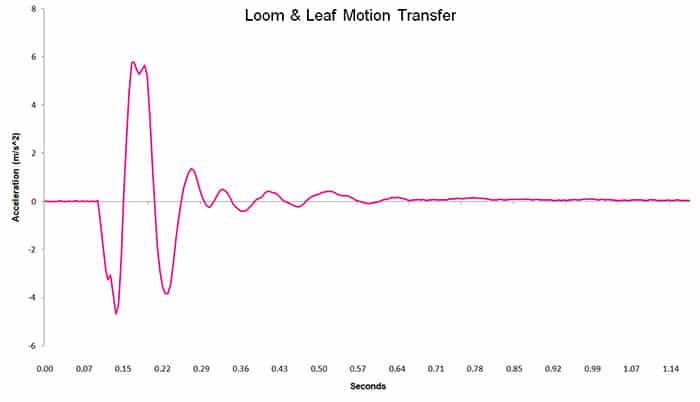
The chart above shows motion transfer in our test of the Loom & Leaf, luxury memory foam mattress. As you can see, there is an initial energy spike from where the ball was dropped in our tests, but that energy dissipated very fast.

For comparison, here is a similar motion transfer chart on the Saatva memory foam hybrid, which uses memory foam and coils. As you can see, it’s amore significant energy spike and the energy continues to bounce across the mattress for over 1 full second.
Disadvantages of Memory Foam
#1. Heat Retention
Traditional memory foams sometimes struggle with heat retention. When warm air gets trapped in memory foam, it can be hard for that heat to dissipate through the mattress. This is just the nature of many viscoelastic poly foams.
Some memory foams try and counteract this by having an open-cell structure or by including additive in the foam like cooling gel or a copper-infused composition.
#2. Poorer Edge Support
Memory foam can sometimes create worse edge support as foam tends to allow for more compression.

Among all memory foam mattresses we’ve tested to date we do see a range of performance. Even though many memory foam mattresses struggle in this area, not all do.
Some mattresses have reinforced edges, which helps counteract that compression, or thinner comfort layers. For example, the organic BedInABox EcoLux, the Ghostbed Luxe, or the Novosbed mattress all had excellent edge performance with scores in the mid to upper 9’s.
What is a hybrid mattress?
A hybrid mattress is any mattress where the layers are made up a blend of various foams and coils.
Most hybrid mattresses utilize a layer of pocketed coils (usually 6-8″) that’s sometimes reinforced with a thin (usually 1″) layer of support foam.
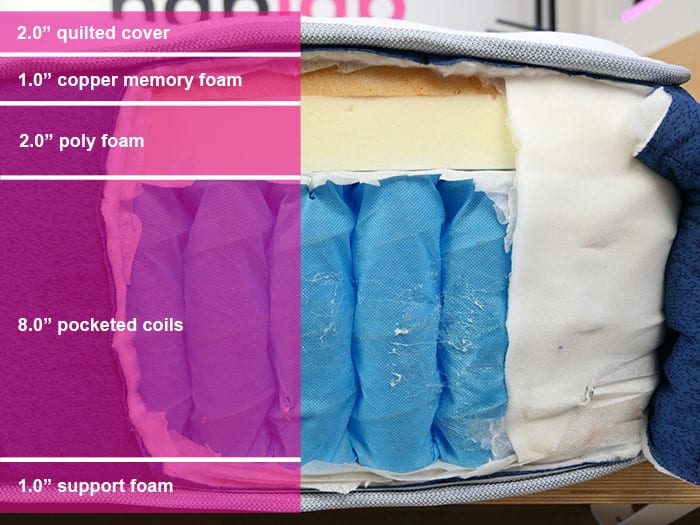
The comfort foam on top usually ranges from 2-6″ of material and can include memory foam, latex foam, poly foam, natural materials, and other types of comfort materials.
What does a hybrid mattress feel like?
Hybrids are designed to take the best of foam mattresses as well as coil mattresses. They tend to have the compression and feel of a foam mattress, but the support coils below provide some pushback for support and pressure relief in the lower layers.
It’s a balanced feel that is active and engaging from coils, while maintaining the deeper hug and contour than foam often provides.
Advantages of a Hybrid Mattress
#1. Faster Response
Many times foam mattresses can have a slower response time. A hybrid integrates coils, which can provide a faster response while maintaining the pressure relief and comfort of foam comfort layers.
#2. Improved Edge Support
Edge support is another area that gets a boost in performance when switching from strictly memory foam to a hybrid. Foam at the edge has a tendency to compress easily and leave you feeling unsupported when sitting at the edge.
On a hybrid, coils can be used for additional edge support and reinforcement. Check out the comparison below between the Nectar Original (all foam) vs. Nectar Hybrid (foam and coils).


As you can see, edge compression is significantly deeper on the all-foam, Nectar Original mattress. Even when foam layers were incredibly similar, simply adding coils to the Nectar Hybrid greatly improved performance.
Disadvantages of A Hybrid Mattress
#1. More Motion Transfer + Bounce
It’s no surprise that coils provide more energy than memory foam. While that energy oftentimes means faster response, it can also mean higher levels of motion transfer and higher levels of bounce.
Bounce is a bit of a preferential factor, but not all sleepers are looking for higher levels of bounce, so it may be something to consider.
#2. Higher Profile
A quality hybrid mattress will oftentimes be a bit thicker than all-foam mattresses. If you don’t prefer the higher aesthetic, this could be something to consider when choosing between the two styles.
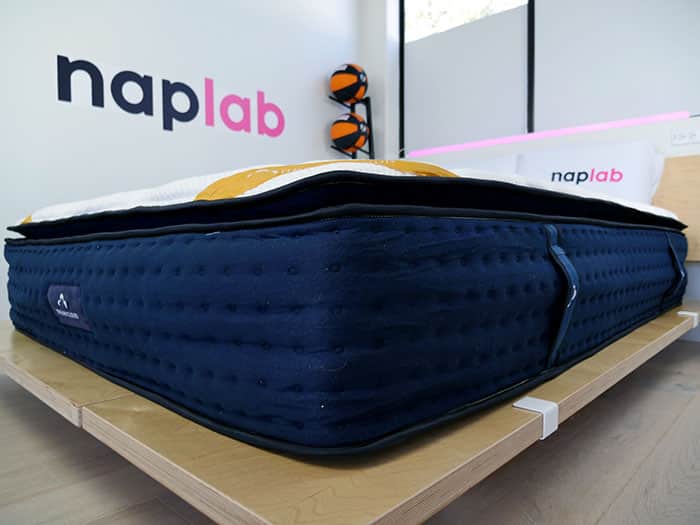
Which is right for you?
So you’ve made it this far… how do you know which mattress is right for you?
Memory foam mattresses are better if you’re looking for:
- More hug and contour
- Less bounce
- Minimal noise
- Less motion transfer
Hybrid mattresses are better if you’re looking for:
- Better cooling
- Faster response time
- Better edge support
- Better sex
FAQ
Depends on what you’re looking for. For compression, hug, contour, and less motion transfer, memory foam is the best option. But if you’re looking for faster response, better edge support, better cooling, better sex, and more of a balanced feel, a hybrid is the better pick.
Generally, foam mattresses can be expected to last 10-15 years. A spring mattress lasts 7-10 years. And a hybrid would be somewhere in the middle—10-12 years. All that being said, the exact lifespan of any mattress depends on who is sleeping on it, foundational support, mattress quality, and other environmental factors.
Firmness is not determined by mattress type. There are ultra soft and ultra firm memory foam and hybrid mattresses, and every firmness in between.
Not always, but in many cases hybrids are more expensive than memory foam mattresses.
To compare apples to apples, check out the Nectar Original (memory foam) and Nectar Hybrid (foam + coils).
Nectar Original: $799
Nectar Hybrid: $999
Hybrid mattresses generally last between 10-12 years.
Not always. A low quality hybrid mattress may squeak or one that does not have enough material between the coils and the sleeper. Pocketing coils or wrapping them in foam are two good ways manufacturers can limit squeaky coils.
Probably not. Most modern mattresses are designed to not need a box spring, but as with most gray areas, it’s always a good idea to check with the manufacturer. Skipping a box spring when one is actually required can void a warranty or cause support issues down the road. Likewise, using a box spring when a foundation, slats, or platform are required can also void your warranty. Always double check with the mattress manufacturer.



